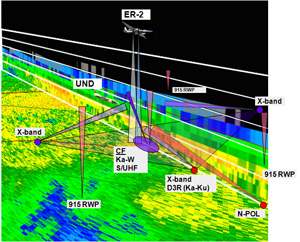
Global Precipitation Measurement (GPM) Ground Validation Program
 |
|
Example of "Stacked" Sampling
|
The NASA Global Precipitation Measurement Mission (GPM) Ground Validation (GV) program as a member of the broader NASA Precipitation Measurement Mission is providing ground and airborne precipitation datasets supporting physical validation of satellite-based precipitation retrieval algorithms. The requisite GV measurements include multi-frequency dual-polarimetric radar (S, C, X, Ka/Ku and W bands), airborne microphysical probe, radar and radiometer observations (e.g., provision of a GPM core satellite "proxy"), and ground-based disdrometer and raingauge network observations as a core instrument and measurement complement. The GPM-GV instrument suite was deployed in numerous field campaigns in several different precipitation regimes. These campaigns and regimes range from the Light Precipitation Validation Experiment (LPVEx; Helsinki, Finland, fall-winter 2010), the Mid-latitude Continental Convective Clouds Experiment (MC3E; Ponca City, OK, April-May, 2011), the Cold Season Experiment (Cold-EX; Ontario, Canada, Jan-Feb. 2012), the NOAA Hydrometeorological Testbed South East campaign (HMT-SE; North Carolina, late summer 2013), and two more out-year field campaigns to be held in FY2015, 2016. The associated GV measurements and observational strategies seek to advance our physical understanding of precipitation processes and assure consistency between this understanding and the representation of those physical processes in NASA GPM retrieval algorithms.






